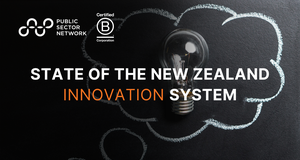Enabling a Technology-Driven Government

Natalia Kacperek,
Director,
Data Analytics and Insights,
Department of the Premier and Cabinet
Western Australia
Technology is a critical government service
Our modern world is filled with technology and data, yet most people take for granted the power of that digitisation. In government departments, even ones that have digital government branches, Natalia Kacperek , the Data Analytics and Insights Director at the Department of the Premier and Cabinet in Western Australia, says that “policy is seen as the holy grail of improving citizen outcomes. But policy can’t solve everything.” A recent case that proved this in the most dramatic of ways was a legal matter concerning new migrants who didn’t quite know the Australian law. Whilst the details of the case are largely irrelevant, one of the lawyers involved came to the conclusion “that she couldn’t help everyone, and in fact, her entire firm couldn’t help everyone.” This was not through lack of trying, but because the relevant legislation hadn’t considered the case of new migrants in this instance, and thus “created this problem, to begin with.” It was therefore a problem that only “the system could address but individual lawyers couldn’t,” though even more than that, “digital technology could address systemic issues on a scale that even legislation and policy could not.”
“In that sense, frontline services are incredibly powerful and they can’t be dismissed, but they really only serve one person at a time. Policy and legislation can serve a few more, but it really is data and digital technology that can have a true impact on a huge number of citizens.”
Natalia Kacperek, Director, Data Analytics and Insights, Department of the Premier and Cabinet WA
Technology has been vital for pandemic management
A practical example of the impact of data and digital comes from the management of and response to COVID-19. WA, like all jurisdictions, has a vaccine and check-in app. In fact, WA has two government-sanctioned apps. Either way, they have “2.2 million registered users. For context, there are about 2.6 million Western Australians, and we are a state that basically hasn’t had COVID-19 for two years.” No other service or program has been able to interact with nearly 85% of the population. “There’s no way we could have had that reach with face-to-face engagement or with a policy change unless it was underpinned by technology.”
Not only has technology changed the way citizens interact with their governments, but because technology has become so prevalent, even the communication paraphernalia that government puts out “uses the iconography of technology to explain its management.” And if the technology wasn’t available, where would the government be in terms of its management of the pandemic? In terms of home quarantine, “we would have relied entirely on things like police checks to ensure people were where they said they were.” For proof of vaccination and contact tracing, “would it have worked using pieces of paper and public servants having to decipher phone numbers and names from scrawled sign-in sheets?” On top of that, though specific and emergency legislation was passed, “the actual implementation of those restrictions would have been impossible without the technology to manage them.”
Since the start of the pandemic, the concept of data linkages has also emerged, “though it is hardly new; it has been around since the 90s.” Nonetheless, it is the process of “anonymously linking data from a number of agencies to understand whole-of-government, and sometimes even whole-of-life, citizen trajectories.” This is particularly necessary when talking about technology because “although legislation is systemic, this is the thing that can underpin that systemic change.” Since it is all interlinked, it can be predictive and can answer questions like “what legislative change can actually lead to behavioural change.” At the federal level, an “initiative like the National Disability Data Asset will link Medicare and pharmaceutical data with state data on educational, health and other outcomes for people with disabilities.” That kind of linkage can “can inform better services and develop more informed policy that better serves the needs of people with disabilities.” This is something that is currently being rolled out and was expedited as a result of the pandemic.
Technology can help the regions
In other areas too, these linkages are critical, and so are priorities. “You can invest money into sending frontline workers to rural areas, or you can boost the technology capabilities.” For instance, there are many opportunities to improve health and judicial outcomes in the remote parts of WA, but much of the progress has been slow and forcibly one-on-one because at best, “there is pretty mediocre internet outside of Perth.” And as we’ve seen, particularly in the remotest parts of the state, “no face-to-face interaction or legislative change can have as much of an impact as digital inclusivity can have.” It will improve healthcare and custodial outcomes, “but without good technology and the internet, people have to travel for hours to access health advice or go to a hearing.” Even when there is the internet, it is often slow, and therefore “remote hearings regularly get cancelled because of poor connectivity.”
However, it is generally not the fault of the communities. For the most part, Australia has prioritised the NBN to “capital cities and the eastern states.” In the rest of the country, and particularly in remote WA, “there really is no internet connectivity at all, so that is the first and biggest barrier.” Though it isn’t the only obstacle. Apart from the internet, for technology to really have an impact, it needs to work with other tools like computers and mobile devices, all of which need to be upgraded. Across almost all of the agencies that deal with vulnerable people, including “health, child protection, and justice agencies, investment has chronically gone to frontline services at the expense of technology.” It is now at the point where “legacy systems have to be overhauled” for the technology to work at all, and that is before connectivity is even considered.
On top of all that, data from the Australian Institute of Health and Welfare (www.aihw.gov.au) suggests that while the government continues to offer incentives for GPs to move to rural areas, “more than to major cities,” unless there will be a GP in every tiny little town, it will make no difference. People still tend to travel great distances to their favourite doctor or don’t go to see a doctor at all. “So think of the impact technology could have.” In fact, it has already had an impact. “Telehealth services went up dramatically at the start of the pandemic, particularly in WA, and they haven’t really come back down.”
A momentum to keep going
Whilst increasing telehealth options was a “proactive measure” to combat a global pandemic, its continued uptake in rural areas suggests there is an appetite for such technology. This shows, in a dramatic way, “that government is being increasingly driven by technology and not by frontline services or policy development.” Data and digital tools therefore can and should be used across the board to help solve all manner of wicked problems, especially with technologies like “IoT and prediction algorithms.” But for the most part, that is not yet the reality on the ground. Public service agencies are still generally “prioritising frontline services and legislative change. But that is not where our citizens expect us to be.” To make long-lasting changes that have a genuine impact, “we have to shift our approaches and workforce priorities over the next few years.”




















